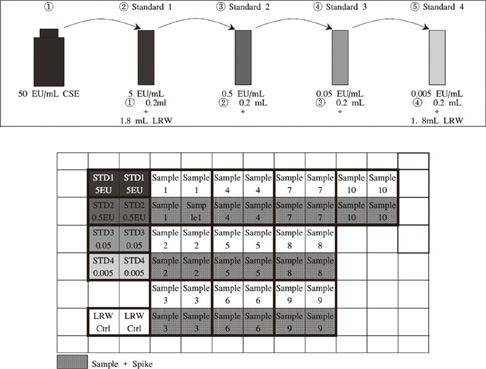J Korean Med Sci.
2012 Sep;27(9):1062-1065. 10.3346/jkms.2012.27.9.1062.
Association of Endotoxins and Colon Polyp: A Case-Control Study
- Affiliations
-
- 1Department of Family Medicine, The Catholic University of Korea School of Medicine, Seoul, Korea. yks6303@catholic.ac.kr
- KMID: 1782140
- DOI: http://doi.org/10.3346/jkms.2012.27.9.1062
Abstract
- Endotoxins are known to be associated with the occurrence of various chronic diseases. This study was conducted to investigate the role of endotoxins in the pathogenesis of colon polyps through a case-control study. A total of 145 subjects (74 subjects in the polyp group and 71 subjects in the control group) had undergone a colonoscopy. Age, body mass index (BMI) and endotoxin levels were found to be significantly higher in the polyp group than in the control group. The endotoxin level was still significantly higher in the polyp group than in the control group, even after age and BMI had been adjusted (polyp group 0.108 +/- 0.007 EU/mL, control group 0.049 +/- 0.008 EU/mL, P < 0.001). In subgroup analysis, the endotoxin level significantly increased in accordance with the number of colon polyps (one-polyp group, 0.088 +/- 0.059 EU/mL; two-polyp group, 0.097 +/- 0.071 EU/mL; three-or-more-polyp group, 0.149 +/- 0.223 EU/mL). The endotoxin levels also significantly increased in groups with tubular adenoma with high-grade dysplasia (hyperplastic polyp group, 0.109 +/- 0.121 EU/mL; tubular adenoma with low grade dysplasia group, 0.103 +/- 0.059 EU/mL; tubular adenoma with high grade dysplasia group, 2.915 +/- 0.072 EU/mL). In conclusion, the serum level of endotoxins is quantitatively correlated with colon polyps.
Keyword
MeSH Terms
Figure
Reference
-
1. Campbell NA, Reece JB, Urry LA, Cain ML, Wasserman SA, Minorsky PV, Jackson RB. Biology. 2008. 8th ed. San Francisco, CA: Benjamin Cummings;452–555.2. Chang S, Li L. Metabolic endotoxemia: a novel concept in chronic disease pathology. J Med Sci. 2011. 3:191–209.3. Simpson S, Ash C, Pennisi E, Travis J. The gut: inside out. Science. 2005. 307:1895.4. Lundin JI, Checkoway H. Endotoxin and cancer. Environ Health Perspect. 2009. 117:1344–1350.5. de Bono JS, Dalgleish AG, Carmichael J, Diffley J, Lofts FJ, Fyffe D, Ellard S, Gordon RJ, Brindley CJ, Evans TR. Phase I study of ONO-4007, a synthetic analogue of the lipid A moiety of bacterial lipopolysaccharide. Clin Cancer Res. 2000. 6:397–405.6. Otto F, Schmid P, Mackensen A, Wehr U, Seiz A, Braun M, Galanos C, Mertelsmann R, Engelhardt R. Phase II trial of intravenous endotoxin in patients with colorectal and non-small cell lung cancer. Eur J Cancer. 1996. 32A:1712–1718.7. Yang JM, Han DW, Xie CM, Liang QC, Zhao YC, Ma XH. Endotoxins enhance hepatocarcinogenesis induced by oral intake of thioacetamide in rats. World J Gastroenterol. 1998. 4:128–132.8. Macarthur M, Hold GL, El-Omar EM. Inflammation and Cancer. II. Role of chronic inflammation and cytokine gene polymorphisms in the pathogenesis of gastrointestinal malignancy. Am J Physiol Gastrointest Liver Physiol. 2004. 286:G515–G520.9. Astrakianakis G, Seixas N, Camp J, Smith TJ, Bartlett K, Checkoway H. Cotton dust and endotoxin levels in three Shanghai textile factories: a comparison of samplers. J Occup Environ Hyg. 2006. 3:418–427.10. Werling D, Jungi TW. TOLL-like receptors linking innate and adaptive immune response. Vet Immunol Immunopathol. 2003. 91:1–12.11. Schmidt C. Immune system's Toll-like receptors have good opportunity for cancer treatment. J Natl Cancer Inst. 2006. 98:574–575.12. Poltorak A, He X, Smirnova I, Liu MY, Van Huffel C, Du X, Birdwell D, Alejos E, Silva M, Galanos C, et al. Defective LPS signaling in C3H/HeJ and C57BL/10ScCr mice: mutations in Tlr4 gene. Science. 1998. 282:2085–2088.13. Hong S, Qian J, Yang J, Li H, Kwak LW, Yi Q. Roles of idiotype-specific T cells in myeloma cell growth and survival: Th1 and CTL cells are tumoricidal while Th2 cells promote tumor growth. Cancer Res. 2008. 68:8456–8464.14. Cappell MS. The pathophysiology, clinical presentation, and diagnosis of colon cancer and adenomatous polyps. Med Clin N Am. 2005. 89:1–42.15. Blue MG, Sivak MV Jr, Achkar E, Matzen R, Stahl RR. Hyperplastic polyps seen at sigmoidoscopy are markers for additional adenomas seen at colonoscopy. Gastroenterology. 1991. 100:564–566.
- Full Text Links
- Actions
-
Cited
- CITED
-
- Close
- Share
- Similar articles
-
- Three Cases of Membranous Reticular Inflammatory Polyp of the Colon
- Two Cases of Colon Polyp Bleeding With Massive Hematochezia in Elderly Patients
- The Recurrence Rate of Colon Polyp after Polypectomy and the Interval of Surveillance Colonoscopy: Predictors of Early Development of Advanced Polyp
- Colorectal Polyps : Endoscopic Diagnosis and Polypectomy
- Incidentally Discovered Solitary Gastrointestinal Polyp with Pathological Significance in Children: Four Case Reports


